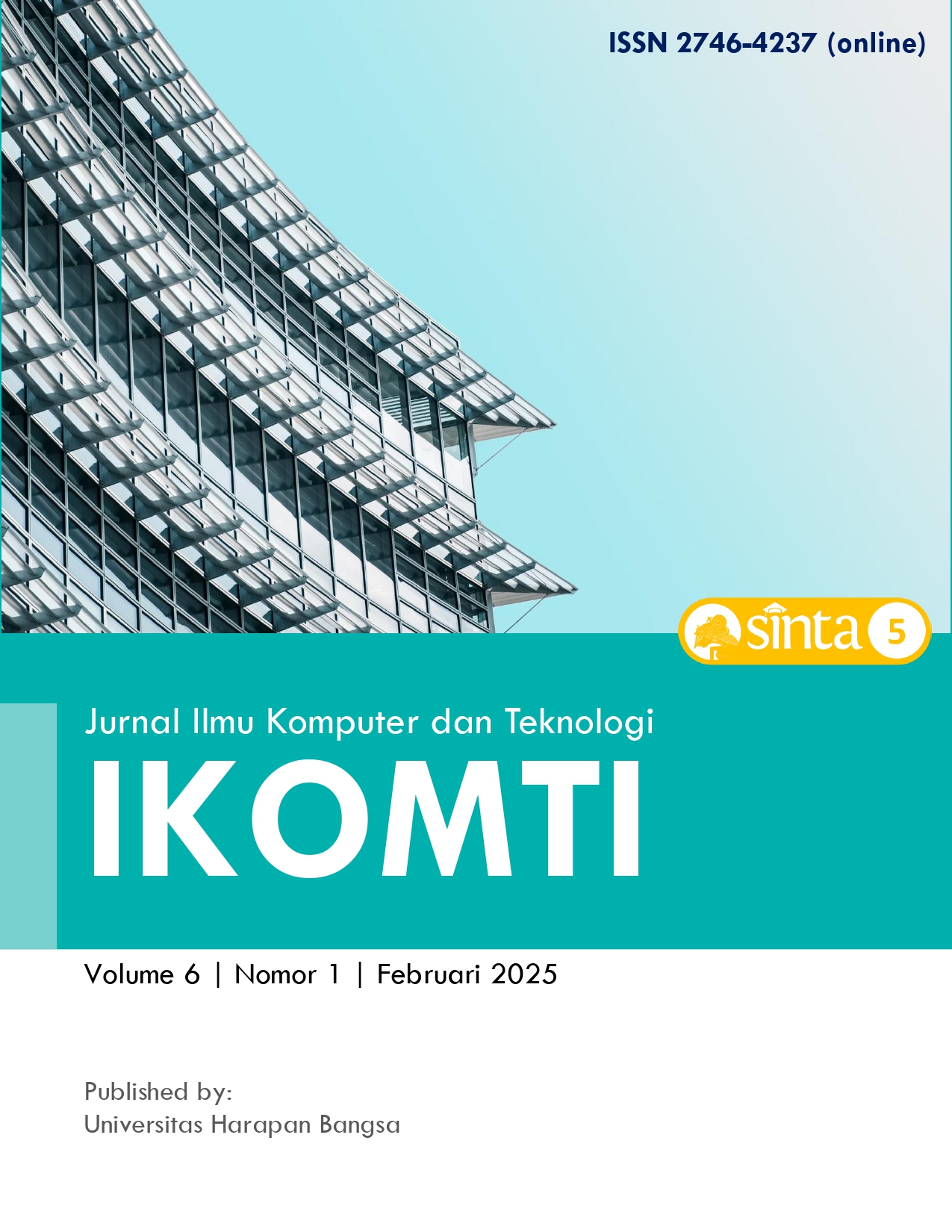Komparasi Kinerja Algoritma Random Forest, Decision Tree, Naïve Bayes, dan KNN dalam Prediksi Tingkat Depresi Mahasiswa menggunakan Student Depression Dataset
DOI:
https://doi.org/10.35960/ikomti.v6i1.1756Keywords:
depresi mahasiswa, algoritma klasifikasi, Random Forest, Decision Tree, Naïve Bayes, K-Nearest NeighborsAbstract
Kesehatan mental, khususnya depresi pada mahasiswa, menjadi isu penting yang membutuhkan perhatian serius. Penelitian ini bertujuan untuk membandingkan kinerja beberapa algoritma klasifikasi dalam memprediksi tingkat depresi mahasiswa menggunakan Student Depression Dataset (SDD). Algoritma yang dianalisis meliputi Random Forest, Decision Tree, Naïve Bayes, dan K-Nearest Neighbors (KNN). Metode yang digunakan mencakup evaluasi performa model berdasarkan metrik akurasi, Precision, Recall, dan F1-score. Hasil penelitian menunjukkan bahwa Random Forest memiliki performa terbaik dalam menyeimbangkan antara Precision dan Recall, sementara Naïve Bayes lebih cocok untuk aplikasi yang memprioritaskan Precision. Temuan ini memberikan wawasan baru dalam penerapan algoritma klasifikasi untuk data kesehatan mental dan menjadi dasar rekomendasi bagi institusi pendidikan dalam menyusun kebijakan yang lebih efektif untuk mendukung kesehatan mental mahasiswa.
References
[1] J. Edwin, J. Cornwall, and K. Du Plooy, “What medical students want from Mental Health Self-Help Resources: A focus group study,” Ment Health Prev, vol. 35, p. 200353, 2024, doi: https://doi.org/10.1016/j.mhp.2024.200353.
[2] H. Liu, K. Zhang, L. Wang, and J. Chen, “Educational burden reduction, educational inequality, and enrollment pressure: Evidence from China,” Econ Hum Biol, vol. 56, p. 101459, 2025, doi: https://doi.org/10.1016/j.ehb.2024.101459.
[3] D. Qu et al., “School mental health prevention and intervention strategies in China: a scoping review,” Lancet Reg Health West Pac, vol. 53, p. 101243, 2024, doi: https://doi.org/10.1016/j.lanwpc.2024.101243.
[4] K. Maximova, M. K. A. Khan, J. Dabravolskaj, L. Maunula, A. Ohinmaa, and P. J. Veugelers, “Perceived changes in lifestyle behaviours and in mental health and wellbeing of elementary school children during the first COVID-19 lockdown in Canada,” Public Health, vol. 202, pp. 35–42, 2022, doi: https://doi.org/10.1016/j.puhe.2021.10.007.
[5] J. Zhang and T. Chen, “Artificial intelligence based social robots in the process of student mental health diagnosis,” Entertain Comput, vol. 52, p. 100799, 2025, doi: https://doi.org/10.1016/j.entcom.2024.100799.
[6] O. Kobo, A. Meltzer-Asscher, J. Berant, and T. Schonberg, “Classification of depression tendency from gaze patterns during sentence reading,” Biomed Signal Process Control, vol. 93, p. 106015, 2024, doi: https://doi.org/10.1016/j.bspc.2024.106015.
[7] M. Wan and S. Zou, “Adolescent mental health state assessment framework by combining YOLO with Random Forest,” Appl Soft Comput, vol. 168, p. 112497, 2025, doi: https://doi.org/10.1016/j.asoc.2024.112497.
[8] A. M. Mariano, A. B. de M. L. Ferreira, M. R. Santos, M. L. Castilho, and A. C. F. L. C. Bastos, “Decision Trees for predicting dropout in Engineering Course students in Brazil,” Procedia Comput Sci, vol. 214, pp. 1113–1120, 2022, doi: https://doi.org/10.1016/j.procs.2022.11.285.
[9] S. S. Sara, Md. A. Rahman, R. Rahman, and A. Talukder, “Prediction of suicidal ideation with associated risk factors among university students in the southern part of Bangladesh: Machine learning approach,” J Affect Disord, vol. 349, pp. 502–508, 2024, doi: https://doi.org/10.1016/j.jad.2024.01.092.
[10] A. Doryab et al., “Identifying Behavioral Phenotypes of Loneliness and Social Isolation with Passive Sensing: Statistical Analysis, Data Mining and Machine learning of Smartphone and Fitbit Data,” JMIR Mhealth Uhealth, vol. 7, no. 7, 2019, doi: https://doi.org/10.2196/13209.
[11] Z. Liu, Y. Liu, J. Dezert, and Q. Pan, “Classification of incomplete data based on belief functions and K-nearest neighbors,” Knowl Based Syst, vol. 89, pp. 113–125, 2015, doi: https://doi.org/10.1016/j.knosys.2015.06.022.
[12] V. Plotnikova, M. Dumas, and F. P. Milani, “Applying the CRISP-DM data mining process in the financial services industry: Elicitation of adaptation requirements,” Data Knowl Eng, vol. 139, p. 102013, 2022, doi: https://doi.org/10.1016/j.datak.2022.102013.
[13] S. Zulfiqar, H. A. Al-Reshidi, M. A. Al Moteri, H. M. B. Feroz, N. Yahya, and W. M. Al-Rahmi, “Understanding and predicting students’ entrepreneurial intention through business simulation games: A perspective of covid-19,” Sustainability (Switzerland), vol. 13, no. 4, pp. 1–27, May 2021, doi: 10.3390/su13041838.
[14] M. F. Uddin and J. Lee, “We Are What We Generate - Understanding Ourselves Through Our Data,” Procedia Comput Sci, vol. 95, pp. 335–344, 2016, doi: 10.1016/j.procs.2016.09.343.
[15] B. C. F. M. Schutijser, J. E. Klopotowska, I. P. Jongerden, C. Wagner, and M. C. de Bruijne, “Feasibility of reusing routinely recorded data to monitor the safe preparation and administration of injectable medication: A multicenter cross-sectional study,” Int J Med Inform, vol. 141, p. 104201, 2020, doi: https://doi.org/10.1016/j.ijmedinf.2020.104201.
[16] T. Hamim, F. Benabbou, and N. Sael, “Student profile modeling using boosting algorithms,” International Journal of Web-Based Learning and Teaching Technologies, vol. 17, no. 5, pp. 1–13, May 2022, doi: 10.4018/IJWLTT.20220901.oa4.
[17] G. Pandolfo, A. D’Ambrosio, L. Cannavacciuolo, and R. Siciliano, “Fuzzy logic aggregation of crisp data partitions as learning analytics in triage decisions,” Expert Syst Appl, vol. 158, p. 113512, 2020, doi: 10.1016/j.eswa.2020.113512.
[18] D. Chicco and G. Jurman, “The advantages of the Matthews correlation coefficient (MCC) over F1 score and accuracy in binary classification evaluation,” BMC Genomics, vol. 21, no. 1, pp. 1–13, 2020.
[19] A. M. G. Milla et al., “Accuracy of visceral adiposity indices and lipid accumulation products in the identification of adults at high cardiovascular risk,” Clínica e Investigación en Arteriosclerosis, 2023, doi: https://doi.org/10.1016/j.arteri.2023.04.002.
[20] X. Niu, Z. Yang, N. Zhou, and C. Li, “A novel method for cage whirl motion capture of high-Precision bearing inspired by U-Net,” Eng Appl Artif Intell, vol. 117, p. 105552, 2023, doi: https://doi.org/10.1016/j.engappai.2022.105552.
[21] Z. A. Rana, M. A. Mian, and S. Shamail, “Improving Recall of software defect prediction models using association mining,” Knowl Based Syst, vol. 90, pp. 1–13, 2015, doi: https://doi.org/10.1016/j.knosys.2015.10.009.
[22] B. C. Yan, H. W. Wang, S. W. F. Jiang, F. A. Chao, and B. Chen, “Maximum F1-Score Training for End-to-End Mispronunciation Detection and Diagnosis of L2 English Speech,” 2022, IEEE. doi: 10.1109/ICME52920.2022.9858931.
Downloads
Published
How to Cite
Issue
Section
License
Copyright (c) 2025 Ismail Setiawan, Ilham Fatah Yasin, Yuninda Tri Desianti

This work is licensed under a Creative Commons Attribution 4.0 International License.













